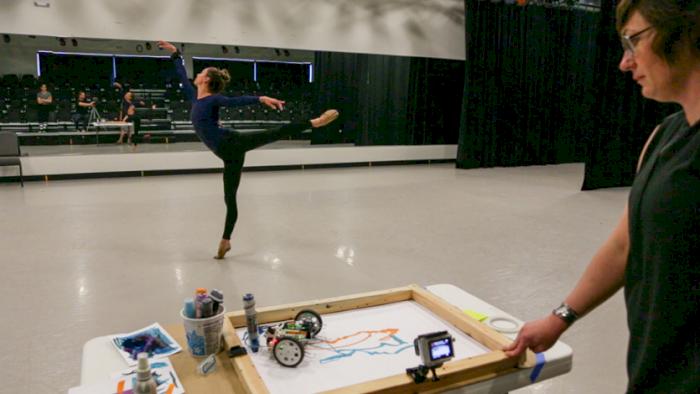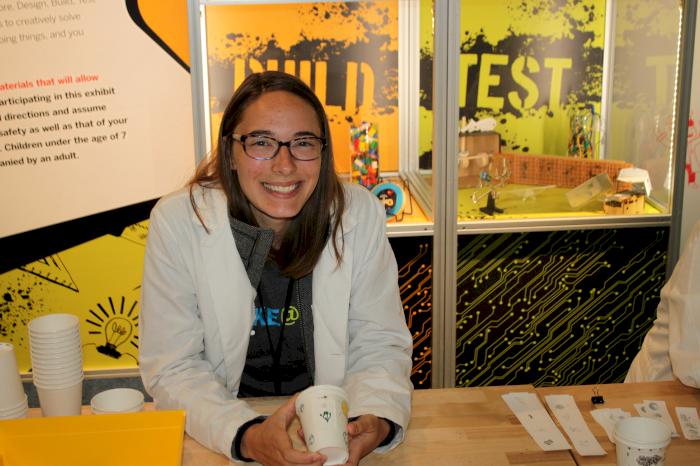Meet a Maker: Amenda Tate Corso
- Wednesday August 29 2018
- Make@SCI
Meet Amenda Tate Corso, an accomplished artist and metal worker. She took some time to chat with us about her approach to making and what inspires her work.
SCI: Can you tell us about what you do?
Amenda: I have been working on a project called the “Manibus Project” for the last year-and-a-half. It utilizes a robotic painting device I created and translates the movement dance and motion into two-dimensional works of art.
SCI: Where does the name “Project Manibus” come from?
Amenda: In Latin, Manibus means “the hand.” I wanted a name that expressed the idea that this project wasn’t replacing the artist by any means. Instead, it acts as an extension of the artist’s hand, or as a new tool that to make or create.
SCI: So it’s a tool that acts on its own, but creates work by an artist?
Amenda: Sort of! It works by using a remote control that senses movement as the input. This allows it to conduct and create the art piece.
I like to think of myself as the overseer or the person that orchestrates the creation of the finished product.
SCI: Where did you get the idea to make a project like this?
Amenda: I had a transformational experience at the ballet, I probably only went to the ballet once before adulthood, and all of the sudden I felt like I was experiencing it in a way that was different from what I perceived it to be. I could see the lines and the shapes. I forgot I was looking at the bodies of the dancers as individual elements, instead I saw them as a whole.
After that, I had a friend that told me about an artist residency program. I really wanted to do something with Ballet Des Moines that was not only inspired by ballet, but directly related to the dancers and what they were doing. In the end, I wanted something that created an impression that was more lasting than just the moment of dance. When you watch a dance recital, you get this emotional high, and then the dance ends, and the moment expires. I wanted it to make something that told the story directly of what was happening in the moment that had a lasting impression. Something that can be analyzed in a different way.
SCI: There’s a huge difference between just taking a video of a ballet recital and displaying it on paper. They give off different types of energy.
Amenda: You can feel the interaction of the energy that was present in that moment. It’s not meant to be an exact reproduction of the movement, but more of a translation of the energy or emotion or the inspiration of it.
SCI: How did you start making?
Amenda: I don’t know if there was a specific time that I can say, “That’s where I got into making,” but I remember something happening as a kid. My parents used to let me use tools, which I thought was fantastic, because some kids don’t get to experience tools until they’re older or there’s a specific need.
I used to take things apart all the time. My dad had a retractable keychain that was broken, and I remember taking it apart to find out what was broken, what happened to it and what made it work, and I fixed it!
There were lots of things like that. For me, it isn’t just about needing to know how things work and why, but more so as an element of expression. I didn’t want to just make something to function. I wanted to make something that does something, tells a story or communicates to us in a way that the everyday world doesn’t.
SCI: What’s your favorite part of the making process?
Amenda: For me, it would have to be seeing the end result. There’s something very satisfying about the process for sure, but I think it’s that point of discovery. Making these works of art are kind of like discoveries, because there isn’t a scripted form. I don’t have a set idea of what it’s going to look like when it’s finished.
SCI: If someone is interested in learning more about making, what would you recommend?
Amenda: Be prepared to fail a lot. Do not be discouraged by making mistakes. I think that a lot of people don’t want to make mistakes, and we all have this fear of making mistakes. If you’re not making mistakes, you’re not trying hard enough to make new things. It’s all part of the process. When you embrace that, you’re on your way to surprising yourself!
See Amenda’s project in action at the Des Moines Mini Maker Faire on Monday, September 3! To learn more, visit http://desmoines.makerfaire.com/, and be sure to check our social media channels for exciting news and updates!


